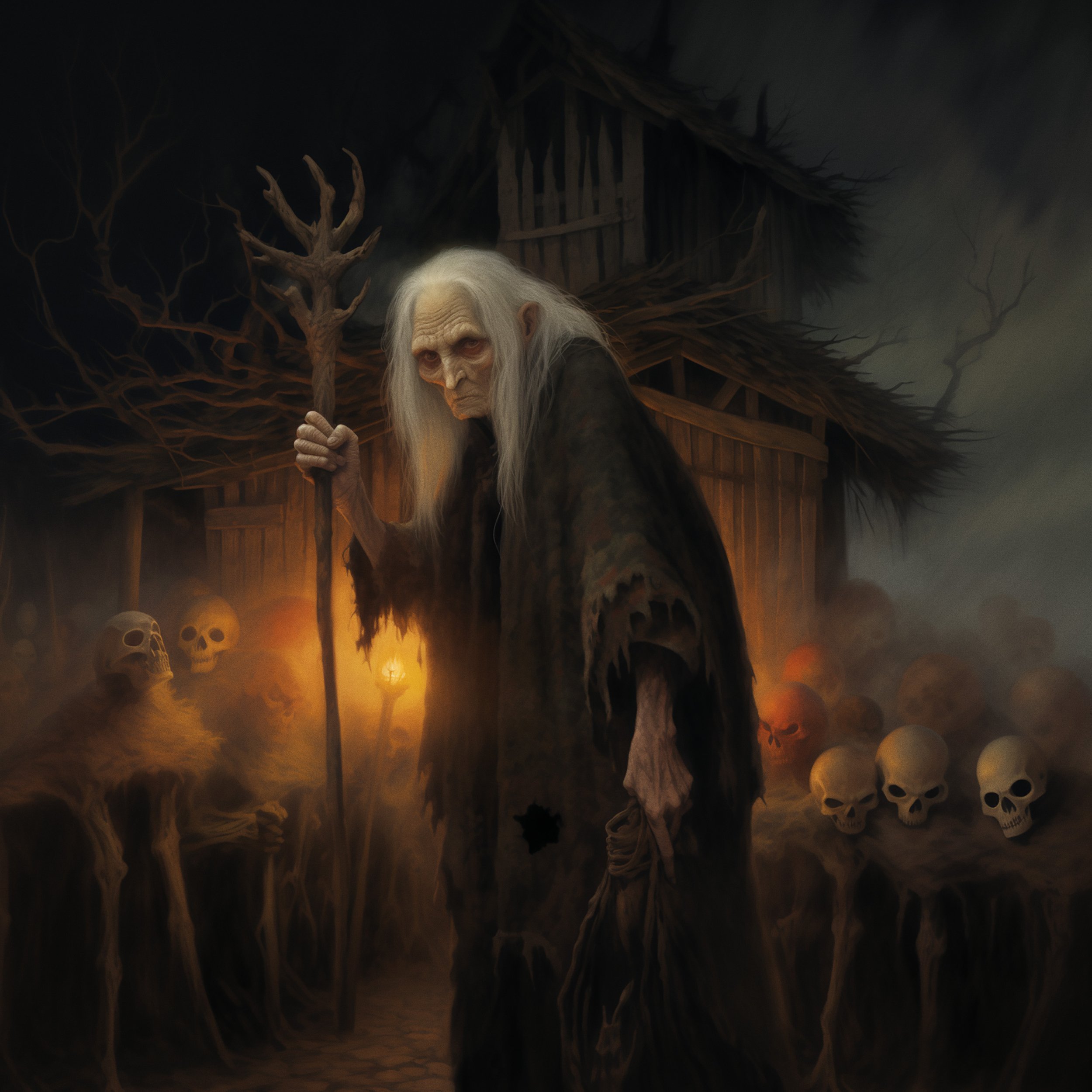Baba Yaga
Deep within the heart of Eastern European forests lies a character whose tales have intrigued generations, captivating minds with eerie mystique. Her name is Baba Yaga, a figure whose stories transcend time and culture, rooted in the rich traditions of Slavic folklore. While not technically a Dark Goddess, I’ve chosen to include her as she is one of the most influential and enduring examples of the terrifying Crone archetype, often referred to as the Witch of the Woods. She possesses a wide array of powers and attributes, each adding complexity to her character. She is a force of nature, embodying the untamed beauty and inherent danger of the wilderness. Her role is multifaceted; she serves as the guardian of the threshold between the living and the dead, occupying the liminal space that few dare to tread.
Baba Yaga is described as an elderly woman, hunched with age, her skin resembling withered parchment. Her eyes, though dimmed by time, hold a penetrating gaze that seems to pierce the very soul of those who meet it. Deep wrinkles etch the landscape of her face, revealing a lifetime of wisdom and enigma. Iron-gray hair, wild and untamed as the forest itself, flows like a cascade down her back. But it is her mouth that commands attention and instills fear—a cavernous maw filled with iron teeth, each one sharp and glistening. When she speaks, her words resonate with the eerie clink of metal, a disconcerting symphony of sound that sends shivers down the spine.
Baba Yaga's attire mirrors the wilderness that surrounds her. She is often clad in tattered, earth-toned rags that blend seamlessly with the forest's undergrowth, making her almost invisible among the trees. Her bony fingers, gnarled and twisted like ancient branches, clutch a long wooden staff, the surface of which is etched with cryptic symbols. Approaching her terrifying cabin in the woods, a hut perched upon giant chicken legs, one encounters an eerie sight. The hut's exterior is weathered and worn, as if it has stood for centuries. Its thatched roof, a mosaic of dried leaves and twigs, blends harmoniously with the forest canopy. The hut seems to crouch, ready to scuttle away into the depths of the woods at the slightest provocation. Baba Yaga's home is not just a structure; it is a living entity with a malevolent spirit of its own. The hut is capable of turning on its legs, pivoting to face visitors, and even uprooting itself to move elsewhere, making it a near-impossible target to locate intentionally. A fence of human bones and skulls, mounted on sharpened stakes, encircles the hut, and as one approaches, the skulls emit eerie moans that send a chill through the heart.
Shape-shifting is among her many talents, allowing her to change her form and size at will, rendering her a formidable and unpredictable presence. Beyond her fearsome facade, Baba Yaga is also a repository of knowledge and wisdom, a sage hidden beneath the layers of her enigmatic personality. She might extend her guidance to those who approach her with respect and humility, offering a glimpse into her complex nature.
Baba Yaga's hideous and sinister stories may be the result of fear and judgment placed on old women, especially those who lived alone or practiced herbal medicine. In the folktales about the Witch of the Woods, Baba Yaga often sets moral challenges for her visitors. She rewards acts of kindness and resourcefulness while punishing arrogance and deceit. Through these stories, Slavic folklore imparts moral lessons and cultural values, emphasizing the interconnectedness of life and death. One story tells of a young girl named Vasilisa who ventured into the deep woods to seek Baba Yaga's help. Armed only with a magical doll given to her by her mother, Vasilisa braved the dangers of the forest, reached the hut on chicken legs, and sought the witch's assistance. Through wit and resourcefulness, Vasilisa not only completed the tasks set by Baba Yaga but also outsmarted the old witch herself. In the end, Vasilisa emerged with the wisdom and tools needed to navigate life's challenges. Another tale speaks of Ivan the Fool, who stumbled upon Baba Yaga's hut during his quest. Encountering her hut on giant chicken legs and skulls encircling it, Ivan seeks knowledge and guidance. Baba Yaga, issuing a challenge, sets him to perform seemingly impossible tasks. With humility, kindness, and resourcefulness, Ivan completes the tasks and outwits Baba Yaga herself, earning her rare compassion. She imparts ancient wisdom, provides him with a feather that transforms into a horse, and equips him for his continuing journey. Ivan's tale highlights the moral values of Slavic folklore, emphasizing the rewards of kindness and resourcefulness while punishing arrogance and deceit, and it showcases the interconnectedness of life and the respect for nature's mysteries woven into such stories.
Baba Yaga is an enduring and layered character whose stories continue to captivate and inspire. Her tales are a testament to the power of folklore, transcending time and place, leaving an indelible mark on the culture of Eastern Europe and beyond. In the depths of the forest, where the ordinary meets the supernatural, Baba Yaga's story lives on—a testament to the enduring power of the human imagination.


